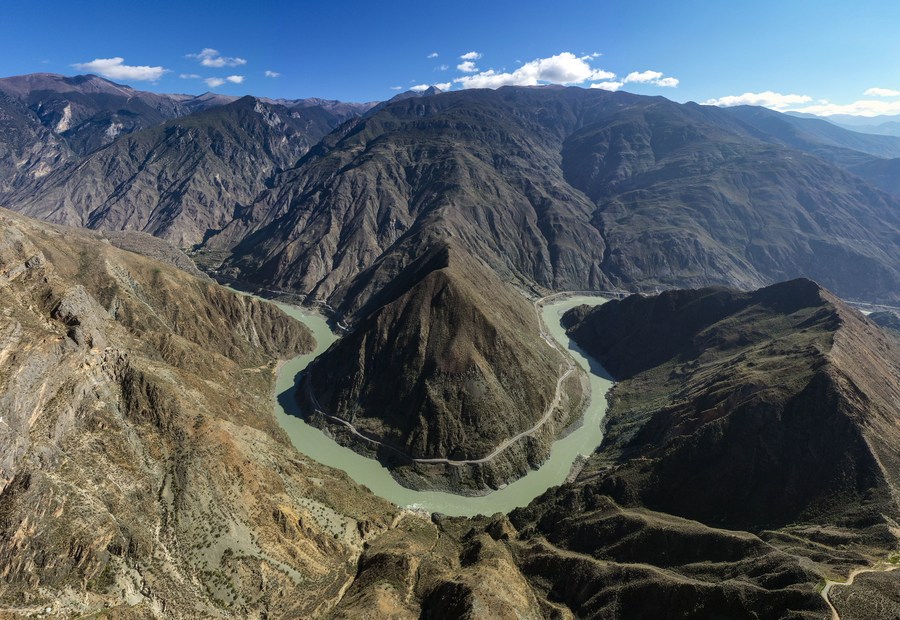Captains set sail on upper section of Yangtze with upgraded facilities

Aerial photo taken on Oct. 27, 2021 shows a bend of the Jinsha River, the upper section of the Yangtze River, in southwest China. (Xinhua/Jiang Wenyao)
CHENGDU, Nov. 27 (Xinhua) -- As a child, Liu Jie was already acquainted with life on the Jinsha River, the upper section of the Yangtze, China's longest river.
From kindergarten into his teenage years, Liu stayed on a boat with his father during his summer and winter vacations.
His father, who worked on a 500-tonne iron ship, was responsible for transporting phosphate ore and coal from the deep mountains to Yibin City in southwest China's Sichuan Province.
The 27-year-old captain recalled that, when he was little, his biggest pleasure was rummaging through the sand and stone cargo for beautiful stones, and he gradually fell in love with everything on board.
Like Liu's father, many others in his extended family have also eked out a living on the water.
In the 1930s and 1940s, Liu's grandparents started operating a small wooden boat on the Jinsha River, hauling goods such as timber downstream for sale.
In those years, navigation conditions on the turbulent river were poor. Even seasoned captains with decades of experience needed to keep an eye on navigation signs to avoid falling into dangerous situations.
His grandparents had to tow the boat when it reached the shallows.
In the 1980s, Liu Jie's father Liu Shuyuan also began running a wooden boat, which he later replaced with an iron boat with a load of 90 tonnes.
At 17, Liu Jie was informed that his father's boat had been involved in an accident on the river. Facing a difficult situation, he decided to drop out of school and learn to run a boat, to help financially support his family.
Over the past decade, Liu Jie, who is also the general manager of a logistics company operating three cargo ships, has grown as a captain on the river.
During the period, the Jinsha River has not only taken on a new look, but has also brought unprecedented opportunities for the shipping industry.
Since 2012, the Jinsha River reservoir area has been formed, consisting of four large-scale hydropower stations: Xiangjiaba, Xiluodu, Wudongde and Baihetan.
Liao Jun, secretary general of Yibin's shipping association, said that before the formation of the reservoir area, there were mostly small-tonnage ships on the river, with a combined capacity of 20,000 to 30,000 tonnes. Currently, most ships operating on the river have a capacity of 3,000 to 4,000 tonnes.
Liao said that although there are about 200 ships operating at full capacity in the reservoir area, it is still difficult to meet the surging demand.
"I am mainly engaged in sand and gravel transportation. There is also strong demand for phosphate ore and coal," Liu Jie said, adding that the net income of one of his ships this year could reach 800,000 yuan (about 112,141 U.S. dollars).
China is vigorously promoting the application of clean energy in the field of ship power. Moreover, the hydrological conditions and waterway length in the Jinsha River reservoir area are suitable for the development of electric ships.
Liu Jie said he plans to invest in the electric ships, which will save him more than 200,000 yuan a year in energy costs and reduce pollution, contributing to the green and high-quality development of the Yangtze River.
Photos
Related Stories
- Knife fish resources recover in China's Yangtze under fishing ban
- Yangtze River estuary sees improving ecology
- Yangtze River Bridge blanketed in clouds
- 1 mln hectares of afforestation completed along Yangtze River Economic Belt
- Yangtze River areas complete 25% of autumn grain harvest amid 'limited impact' from record drought
- China to consolidate environmental protection of Yangtze River basin
Copyright © 2022 People's Daily Online. All Rights Reserved.









